| |
Discovery of a novel class of Hepatitis C Polymerase Inhibitors
|
| |
| |
Reported by Jules Levin
14th International Symposium on Hepatitis C Virus & Related Viruses, Glasgow, UK, 9-13 September 2007
Origene Nyanguile, Frederik Pauwels, Wendy Mostmans, Jean-Francois Bonfanti, Carlo W. Boutton, Walter Van den Broeck,
Ludo M.M. Quirynen, Tania Ivens, Frederic Doublet, Anne-Sophie Rebstock, Pierre Raboisson and Kenneth A. Simmen
HCV Research, Tibotec, Mechelen, Belgium
AUTHOR CONCLUSIONS
We have identified a novel class of hepatitis C NS5B polymerase inhibitors: 1,5-BZDs.
Preliminary SAR analysis led to the identification of compound 4.
Only enantiomer 4a is capable to bind specifically to NS5B.
For cellular activity, future studies are needed to confirm efficacy because of the discrepancies observed between the biochemical and the cellular assay.
The mode of inhibition is non-competitive with respect to GTP, suggesting that this series binds into a nonnucleoside binding site. Characterization of this binding site will be addressed using mutant enzymes and structural biology approaches.
Abstract
The NS5B RNA-dependent RNA polymerase (RdRp) is an attractive target for drug discovery because of its vital role in viral replication and the lack of RdRps in humans. The search for HCV polymerase inhibitors has resulted in the identification of several non-nucleoside inhibitor chemotypes including benzimidazole, indole, thiophene, phenylalanine, dihydropyranone, pyranoindole, proline sulfonamide, benzothiadiazine, benzylidene, acrylic acid and benzofuran derivatives.1 Here, we report the discovery of a novel class of HCV polymerase inhibitors.
A high-throughput assay based on RNA primer extension using recombinant genotype 1b NS5B _21 enzyme and a scintillation proximity detection format was used to screen a diverse library of small molecules. We identified a number of novel inhibitor classes with low micromolar potency, including racemic 1,5-benzodiazepines. Given the knowledge around this type of chemistry, this series was explored further. The 1,5-benzodiazepines were confirmed as active in a primer-independent biochemical assay utilizing an RNA transcript from the HCV 3'-UTR as template. Fluorescence quenching and kinetic experiments indicated that binding to NS5B was specific, and non-competitive in respect to GTP. Selectivity assays with human, HIV and dengue polymerases supported the specificity of this class of 1,5-benzodiazepines for the HCV polymerase.
RESULTS
Identification of 1,5-benzodiazepines
High throughput screening for NS5B polymerase inhibitors led to the identification of 1,5-benzodiazepines (BZDs) 1 and 2 (Table 1) with micromolar activity in the biochemical NS5B assay (IC50 = 3.1 _M and 7.9 _M respectively), but poorly active in replicon cells.
Parallel screening in replicons resulted in the identification of 3, a 1,5-BZD analogue that displays better cellular activity (EC50 = 5.8 _M). This analogue was confirmed to inhibit NS5B in the enzymatic assay (IC50 = 3.0 _M).
1,5-BZDs 4 and 5 combine the diverging features of 1 and 3, i.e. a chloride atom at the ortho or meta position of the phenyl ring and the O-benzyl moiety at the para position respectively.
Table 1. NS5B enzyme assay IC50 values, replicon cell-based assay EC50 values and replicon counterscreen CC50 values for compounds 1-3.
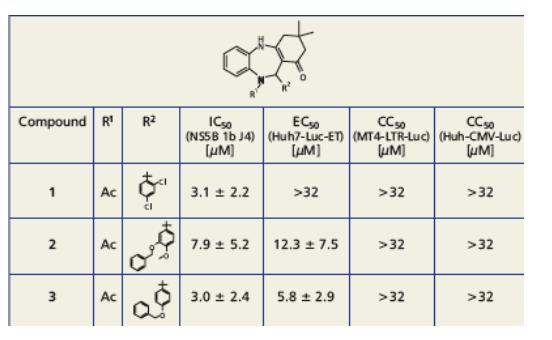
The binding of 1,5-BZDs to the polymerase is stereospecific
High-pressure liquid chiral chromatography (HPLC) separation of BZD 4 yielded the pure enantiomeric forms 4a and 4b.
Only 4a was able to inhibit the NS5B polymerase. However, no clear differentiation could be observed in the cellular assay (Table 2).
Table 2. NS5B enzyme assay IC50 and Ki values, replicon cell-based assay EC50 values and replicon counterscreen CC50 values for compounds 4-6.
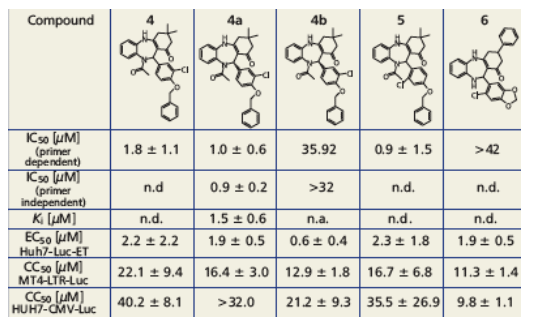
In a fluorescence quenching assay, 4a considerably quenched the intrinsic fluorescence of the polymerase while the effect observed with 4b was only minor and similar to derivative 6, an analogue found to be inactive in the RdRp assay (Fig.1).
Fig. 1. Fluorescence quenching assay. Binding isotherms of 1,5-BZDs with NS5B _21 (1b J4). The level of quenching F0-F in function of compound concentration, at emission maximum of 335 nm, is calculated by subtraction of the fluorescence F of the polymerase/inhibitor complex from the initial fluorescence F0 of the polymerase only.
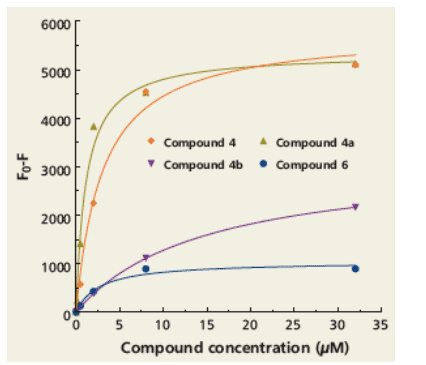
These data demonstrate that only the enantiomer 4a binds specifically to NS5B, and not 4b.
To investigate if the discrepancy observed in the cellular assay was due to the fact that 4b inhibits NS5B only by a primer independent de novo mechanism2, the BZD analogues were tested in a 3'-UTR primer independent assay.
Only 4a was able to inhibit the polymerase in the de novo assay (Table 2).
Altogether, these data suggest off-target activity in cells. Further exploration is warranted to find out if HCV replication can be inhibited specifically with this series in a cellular setting.
1,5-BZDs are non-competitive with regard to GTP
Replication inhibition by 4a was assessed in the presence of high or low concentrations of GTP.
The dose response curves were not affected by either concentration of nucleotide substrate (Fig.2). IC50 values were 1.0 and 1.3 _M, for a GTP concentration of 20 nM and 200 _M respectively. The Km value for GTP of 0.3 _M correlated well with previous findings3 and remained unaffected in the presence of increasing concentrations of 4a.
Fig. 2. Influence of GTP on the inhibitory activity of 1,5-BZD. The HCV polymerase NS5B delta21 (1b J4) was incubated together with poly(rC)/oligo(rG13) template, different concentrations of inhibitor and either 20 nM or 200 _M of GTP. Dose response curves were generated by non-linear regression to determine the IC50 values.
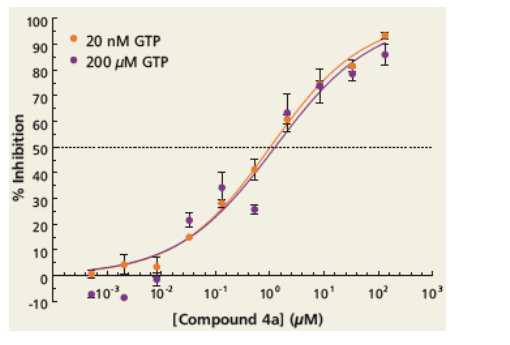
A double reciprocal plot of the initial velocities reveals a noncompetitive nature of inhibition (Fig.3B). Note that the intercept is shifted below the x-axis, indicating a deviation from true non-competitive inhibition, also referred to as mixed inhibition.
Fig. 3. Determination of the mode of inhibition and Ki of 4a. (A). Reaction velocities were measured at different GTP concentrations in the presence of either 0 _M (brown ball), 0.5 _M (orange dot), 1 _M (purple triangle), 2 _M (dark blue triangle) or 4 _M (light blue square ) of inhibitor with primer/template
concentration being fixed. (B) The lines on the double reciprocal plot intersect in the third quadrant reflecting a case of (mixed) non-competitive inhibition. Non-linear regression according to formula 1 gives a Ki value of 1.5 _M and _ ≠ 1.
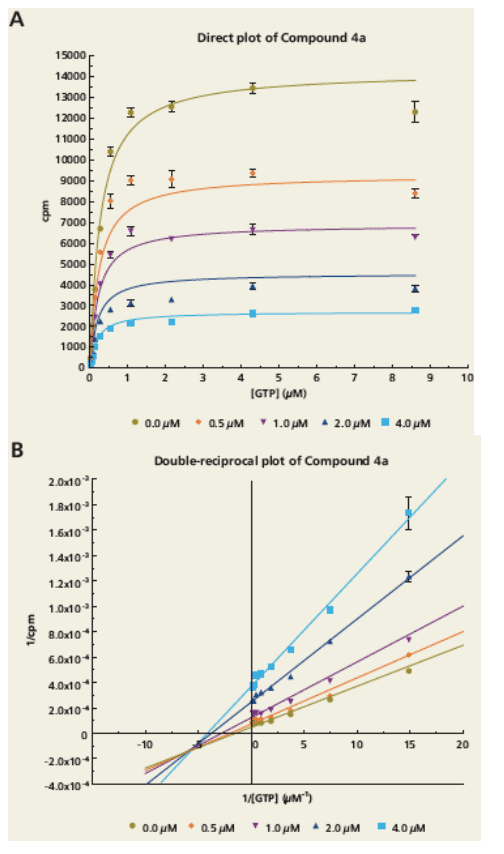
Antiviral specificity
1 and 2 were tested against a panel of recombinant human polymerases, a HIV reverse transcriptase and a dengue polymerase (Table 3).
Only minor inhibitory activities could be detected against the human polymerase _ for 1 (30% inhibition at 100 _M).
Table 3. Human polymerase, HIV reverse transcriptase (RT) and dengue polymerase enzyme assay IC50 for compounds 1 and 2.
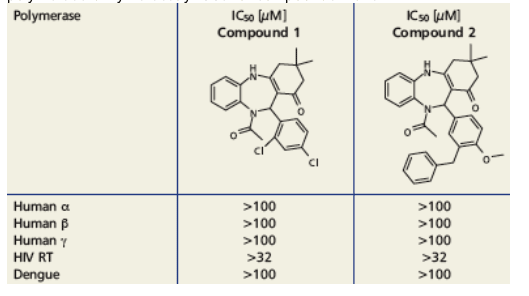
Experimental Procedures
Determination of the kinetic behaviour of the1,5-BZDs - The mode of inhibition of the 1,5-BZDs was determined using the previously described RNA-dependent RNA polymerase extension assay.3 Reaction velocities were measured at different GTP and inhibitor concentrations ranging from 0.0084 - 8.6 _M and 0 - 4 _M, respectively. The concentration of the NS5B _21 (1b J4) polymerase used was 100 nM. Kinetic data was graphically represented either as a double-reciprocal plot or as a direct plot. For the double reciprocal plot, data points were fitted by linear regression to identify the mode of inhibition. Based on this outcome a non-linear regression was used to fit the data in the direct plot according to a non-competitive model of inhibition (see formula 1).

Fluorescence quenching assay - The assay was performed in a 96-well UV transparent microplate (Corning 3635) in a total volume of 200 _l per well. The NS5B _21 (1b J4) polymerase was diluted to a final concentration of 1 _M in RNase free water containing 20 mM Tris HCl (pH 7.5), 25 mM KCl and 7 mM MgCl2. Compounds were serially diluted (in 50% DMSO) and 2 _l per well was added to the enzyme solution. After 5 minutes incubation of the compound-enzyme complex, the fluorescence emission spectrum was scanned from 310
to 400 nm with an excitation wavelength of 280 nm, using the SpectraMax Gemini fluorescence reader. Under these conditions, the tryptophan residues in the enzyme are selectively excited to emit at the maximum wavelength of ca. 335 nm. Due to changes in local environment of the enzyme or to direct interactions of a compound with the enzyme, the intrinsic fluorescence of this enzyme is quenched.
Human, HIV RT and dengue polymerase assay - The human and Dengue virus polymerase assays were performed by Replizyme Ltd. Briefly, each enzyme/compound combination was tested in duplicate over a range of concentrations from 0.8 mM to 100 mM. The compounds were run alongside a control (no inhibitor), a solvent dilution (0.016% to 2% DMSO) and the relevant Replizyme reference inhibitor. The HIV RT assay was run in house. The N-terminal hexahis HIV RT expression construct was transformed in BL21(DE3), after which protein expression was induced overnight at 37C with 0.4 mM IPTG. The homodimer was purified by Ni-NTA and heparin chromatography by apparent homogeneity on SDS PAGE. A scintillation proximity assay was used to measure inhibition of HIV RT activity at 2.5 nM enzyme concentration using the Amersham SPA kit and efavirenz as a reference control.
Replicon luciferase assay and counterscreens - The HCV 1b subgenomic luciferase reporter replicon (bicistronic replicon clone ET obtained from R. Bartenschlager, adapted from Lohmann et al.4) was used to measure anti-HCV activity. The counterscreen cell lines were a Huh7 hepatoma cell line (Huh-CMV-Luc) containing a HCMV-MIEPLuc construct, and an MT-4 T cell line (MT4-LTR-Luc) containing an LTR-Luc reporter. Cells were incubated with compounds plated in a 384-well in 9 point dilution (1/4 dilutions) format for 3 days; antiviral activity was then detected by the measurement of luciferase activity.
References
(1) Koch, U. and Narjes, F. 2007. Cur. Top. Med. Chem. 7: 1302.
(2) Butcher, S. J. et al. 2001. Nature 410: 235.
(3) Pauwels F. et al. 2007. J. Virol. 81: 6909.
(4) Lohmann et al. 1999. Science 285: 110.
|
|
| |
| |
|
|
|